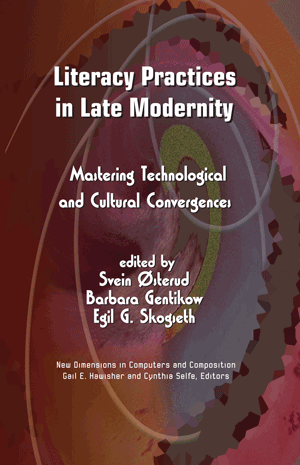Literacy Practices in Late Modernity: Mastering Technological and Cultural Convergences (Østerud, Ge | |
|  | Quantity in Basket:none
Code: 978-1-61289-067-8
Price:$28.95
Title: Literacy Practices in Late Modernity
Sub-title: Mastering Technological and Cultural Convergences
Editor(s): Svein Østerud, Barbara Gentikow, and Egil G. Skogseth
Publish Date: January 2012
Pages: 272
Format: Paper
| |
| This book opens with an historical perspective on literacy, arguing that literacy has gradually reached new social classes in Europe. Literacy has also become a more complex due to technological innovation. Whereas literacy has historically been defined as the ability to read and write printed words and images, the emergence of digital media has contributed to new understandings and combinations of modalities in texts, including animations, graphics, and audio. As computer technologies and new media forms have been transformed, so have the means of distribution changed from mainly print to a stream of bytes accessed through the Internet.
In this book, literacy is understood as a fairly established set of social practices that people draw on in encounters with quite specific challenges and technologies. The twelve chapters explore communication processes in which voice, data and media merge, each chapter bringing to light the kinds of literacies that are practiced and developed in film and TV reception, e-mail and Web communication, schools and museums, Internet-based political forums, and marketing campaigns. Many of the chapters argue that the development of literacy is best served by breaking with historical divisions between not only individual disciplines, but also between in-school and out-of-school literacies.
Contributions are from research centers specializing in education, media and design, and the authors investigate literacy from different professional perspectives.
Contents: Acknowledgments. Changing Concepts of Literacy: From Reading and Writing to Cultural Practices, Svein Østerud. PART I: READING, WRITING, WATCHING: CHALLENGES TO HABITUALIZED LITERACIES. Conceptual Problems of Visual Literacy, Paul Messaris. The Need for New Perceptual Literacies: Watching Television in Digital Times, Barbara Gentikow. Facing Faceless Faces: Exploring the Necessityof New Competences for E-mail and Web Communication, Jeppe Bundsgaard. PART II: POLITICAL LITERACY. Democratic Citizenship, Political Literacy, and Electronic Communication Media, Knut G. Andersen. Activism in a Networked World: What Does English Citizenship Education Have to Offer?, Egil G. Skogseth. Multiple Literacies for the Age of the Internet, Julie Frechette. PART III: RECONTEXTUALIZING KNOWLEDGE. Visualizing Abstractions: The Use of Diagrams and Conceptual Maps in Reasoning Practices, Ivar Solheim. Literacy as Recontextualization: Reformulating the Norwegian Curriculum to Take Account of Student Engagement With Digital Media, Svein Østerud. Real-Life Meaning in Second Life Art, Palmyre Pierroux. PART IV: THE LITERAC OF USER GENERATED ARTIFACTS. Laying Eggs in Other People’s Pockets: Marketing Multiliteracies Via Mobile Technologies, Andrew Morrison AND Synne Skjulstad. Mirroring the Surfaces of the Self: Exploring Literacy Practices of Digital Storytelling, Kenneth Silseth and Ola Erstad. About the Contributors. Author Index. Subject Index
|
| |







